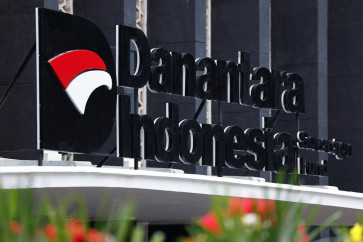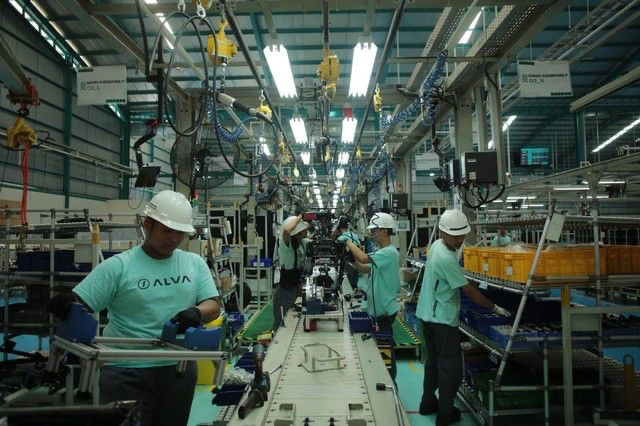Popular Reads
Top Results
Can't find what you're looking for?
View all search resultsPopular Reads
Top Results
Can't find what you're looking for?
View all search resultsSolusi Tunas to build 1,000 telco towers
Towering business: PT Solusi Tunas Pratama president director Nobel Tanihaha (second right), accompanied by director Eko A
Change text size
Gift Premium Articles
to Anyone
 Towering business: PT Solusi Tunas Pratama president director Nobel Tanihaha (second right), accompanied by director Eko A. Saleh (left to right), finance director Juliawati Gunawan, president commissioner Jennivine Yuwono and director Yan Haryana, converse after a presentation in Jakarta on Thursday. (Antara/Audy Alwi) (second right), accompanied by director Eko A. Saleh (left to right), finance director Juliawati Gunawan, president commissioner Jennivine Yuwono and director Yan Haryana, converse after a presentation in Jakarta on Thursday. (Antara/Audy Alwi)
Towering business: PT Solusi Tunas Pratama president director Nobel Tanihaha (second right), accompanied by director Eko A. Saleh (left to right), finance director Juliawati Gunawan, president commissioner Jennivine Yuwono and director Yan Haryana, converse after a presentation in Jakarta on Thursday. (Antara/Audy Alwi) (second right), accompanied by director Eko A. Saleh (left to right), finance director Juliawati Gunawan, president commissioner Jennivine Yuwono and director Yan Haryana, converse after a presentation in Jakarta on Thursday. (Antara/Audy Alwi)
T
span class="caption" style="width: 510px;">Towering business: PT Solusi Tunas Pratama president director Nobel Tanihaha (second right), accompanied by director Eko A. Saleh (left to right), finance director Juliawati Gunawan, president commissioner Jennivine Yuwono and director Yan Haryana, converse after a presentation in Jakarta on Thursday. (Antara/Audy Alwi)
Telecommunications tower company PT Solusi Tunas Pratama (SUPR) is planning to build 800 to 1,000 new towers this year to reach its growth target of 50 percent.
According to SUPR president director Nobel Tanihaha, many of the towers will be in urban areas, especially Jakarta.
'About 65 percent of our existing towers are in Jakarta. The rest are in Java, Sumatra and other regions,' he said in Jakarta on Thursday.
The company operates more than 2,500 towers. About 200 were built this year.
SUPR is splashing out Rp 1.5 trillion (US$154 million) in capital expenditure (capex) for this year's expansion.
A big chunk of the money will be spent on construction of new towers: one tower costs Rp 1 billion to Rp 1.2 billion.
The rest of the funds will build last mile connections for SUPR's fiber optics business.
Nobel said that the company would also look for existing towers to take over. 'We don't know how much we will spend on acquisitions because the price will vary. In the past, the least we spent was Rp 700 million per tower and the most was Rp 1.2 billion,' he said.
One of SUPR's objectives this year is to develop 'microcells' ' low power towers. A microcell is a mini cellular tower with limited coverage, such those at shopping centers or office complexes.
Construction of a tower usually takes about three months.
SUPR generated the capex budget in a syndicated bank loan from Standard Chartered Bank and DBS Bank.
The $300 million loan, secured in March, matures in five years: $258 million in a fixed-term loan and a combination of $25.8 million and Rp 250 billion in revolving loans.
The company wants a 50 percent rise in revenues to Rp 794 billion by yearend. It will also increase its tenancy ratio to 1.7 from 1.6 last year. It means that for every 10 towers, SUPR will have about 17 tenants.
In fiber optics, it will establish last mile connections to connect its Jakarta towers but has no plans to expand to other cities.
The company already has 1,000 kilometers of fiber optic network in Jakarta and 180 kilometers in Bandung, West Java.
The company announced that revenues grew by more than a half to Rp 162.67 billion in Q1 from the same period last year.
As of March 2013, it had 3,065 sites and 4,555 tenants.
According to its financial statement, Bakrie Telecom is the biggest contributor to SUPR revenue with 26 percent, followed by XL Axiata with 15.3 percent, Ericsson with 14.7 percent, Telkom with 8.3 percent and Telkomsel with 7.1 percent.
SUPR saw an increase in costs as well between January and March 2013, climbing 51.9 percent to Rp 36.4 billion.
Despite increasing costs, it booked higher Q1 profits, up 28.9 percent to Rp 51.8 billion.
The company had 5.2 trillion in total assets at the end of March.
Liabilities reached Rp 3.16 trillion and equities stood at Rp 2.03 trillion.
SUPR shares closed at Rp 6,400 on Thursday, up 18.5 percent on the previous day.









